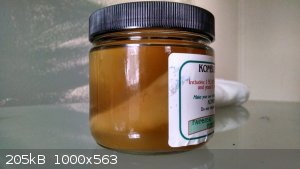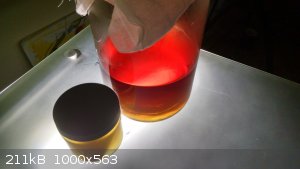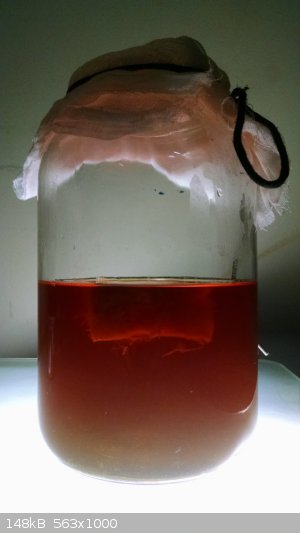
mayko - 18-1-2016 at 12:13
I've seen threads about brewing hooch, but I don't think there's one about brewing booch! I decided to try to get some kombucha growing as a first
project in a micro/molecular biology offshoot of my lab.
What is kombucha?
Kombucha is a drink made from sweet tea, fermented by a symbiotic colony of bacteria (Gluconacetobacter) and yeast (usually Sacchromyces). Fresh
kombucha contains live culture and is thus a probiotic; there are health benefits claimed of it but it is also very tasty.
How does it work?
A small colony (called a 'SCOBY': 'symbiotic colony of bacteria and yeast') is introduced to green or black tea sweetened with surcrose. Over time,
the yeast and bacteria digest the surcrose, producing ethanol, gluconic acid, and acetic acid; the bacteria further oxidize the ethanol from the yeast
to acetic acid. The bacteria also produce a substance called microbial cellulose, which gives structure to the colony. It has also been processed into
textiles!
Important points
Keep a close watch for contamination; definitely don't drink moldy booch
A metal brewing container is bad for the culture, and I have seen reports of heavy metal contamination from ceramics. Glass is best.
Booch is unlikely to cure your cancer/gonorrhea/miscellaneous aches and pains... seek medical attention for those. Nor is it inherently benign
under all use cases; the immunocompromised in particular should be aware that it is a live culture.
------------------------
I picked up a SCOBY from FarmsteadFerments by way of Fifth Season, a local hydroponics and homebrew store (also a great source of sugars, metabisulfite and concentrated peroxide!).

Following the included instructions, 1/2 cup of sucrose was dissolved in 1 quart of boiling water. Another quart of water was then added, as well as
two tea bags of orange pekoe black tea. (The instructions called for 4 tea bags, but these were 'family size', requiring 4 cups per bag.)

Once cool to room temperature (it is IMPORTANT not to scald the colony!) the sweet tea was poured into a clean glass 1-gallon jar. The SCOBY was added
to the tea, and the jar was covered with cheesecloth to exclude dust and mold spores, while allowing gas exchange.


If all goes well, the fermentation process will take hold, and within about a week it will be ready to drink. As fermentation progresses, it will
become less sweet and more sour. Once the liquid starts to get low, it can be topped off with more sweet tea (the instructions in fact suggest a
continuous fermentation container with a spiquot, so that the liquid can be drawn off from the bottom and refreshed from above, all without disturbing
the colony!) With time, a white film is expected to form across the surface of the liquid. This is a new colony growth which eventually can be
propagated to make more cultures.
UC235 - 18-1-2016 at 12:29
I've had various kinds of Kombucha and they all taste like vinegar to me. I can't stomach any of it.
violet sin - 18-1-2016 at 23:27
I love the stuff. I don't have regular time home to maintain mine, and the mother-in-law stopped making it also  so I no longer have a supply at home nor at work.
so I no longer have a supply at home nor at work.
It deffinitely, 100% for sure, made my crappy shoulder feel better when I drank it often. I liked it well aged, dark and lots of flavor. I would
actually let each batch of kombucha sit for 1 - 3 months before drinking it.
It kinda burns your throat a bit, but the extra flexibility and resistance to inflammation I grew to love. Seemed like I could work more and still
feel better the next morning, than if I had only worked a half day without it. Not immediately, 4 or more days was when it was pretty obviously
beneficial to me. Some people don't care for the flavor even when it worked, and other people noticed nothing at all.
Some times I drank upward of 1/2 gal/day, usually much less. You have to have a routine when you make it your self. My wife tried several times to
pour off and start the new batch for me, but it kept getting contamination. I lost a batch or 3 first starting out. A plan and a rhythm makes it
pretty easy to get reliable output.
breakage in pouring the hot tea/sugar was a first mistake. Learned to wash the jars in straight hot water from the tap first. Got the glass at least
partially warmed up. Towels around the 1gal glass jars, sitting on a wooden cutting board. Then pour hot tea and immediately cover the tops with a
coffee filter and the jar with a towel. Slow cooling to room before putting the scoby back in.
A portion of the sugar was already in the jar to cushion against boiling tea at the bottom rim. Had one crack right around the bottom perfectly one
time, what a mess. And the rest of the sugar was added via funnel to the stirred tea. The funnel was pretty much sterilized from hot tea, and
minimized air contact from the large size of the opening normally. If you did it fast, while everything was piping hot, there was no undissolved pile
of sugar in the bottoms, no contamination. Just a few hours to wait while it cooled. Then slip in the freshly washed scoby, from it's temporary
Tupperware home. Done.
It was fun, it feels like a lab the way you prepared, executed and clean up afterward. Benefits or not, I like the taste.
----------edits--------
I don't like adding the sugar to a large enough pan of water to do the 3 one gallon jars used each time. Way too much surface contact with the now
nutrient rich solution. It spoiled on me like that. You could however add hot water to tea bags/sugar or add hot tea to sugar, in the bottom of the
jars reliably.
My scoby's could grow about an inch of thickness to the roughly 8" diameter colony at a staggering rate in the summer! in one week, actually. I was
trying to give them away left and right 
[Edited on 19-1-2016 by violet sin]

 so I no longer have a supply at home nor at work.
so I no longer have a supply at home nor at work.